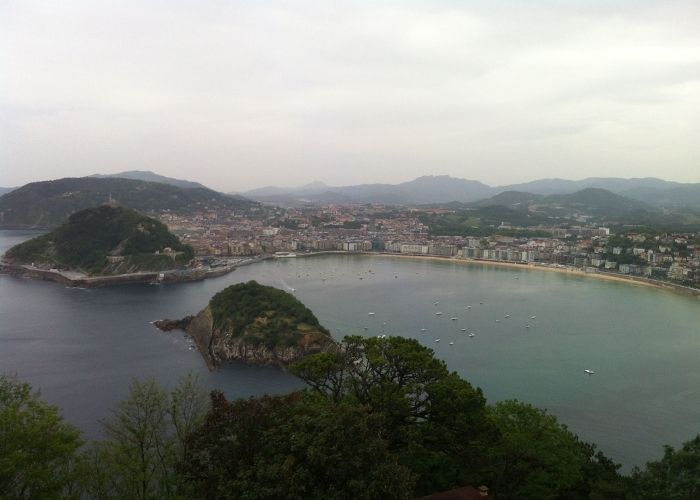BASQUE COUNTRY – Perched on the northern Atlantic coast, near the border of France, the Basque Country – locally known as Euskadi or País Vasco (‘the land of Basque Speakers’) – has its own language, its own culinary traditions, and a distinctive geographic and cultural landscape.
To experience the best of the Basque Country, it is recommended to rent a car. This will enable you to explore the dramatic clifftop landscape at your own pace. Alternatively, you can take the scenic route, and drive from Bilbao to San Sebastian.
When travelling through the Basque country in northern Spain, you’ll encounter breath-taking coastal vistas, green mountain slopes, rocky landscapes, and tranquil farms. You’ll also meet Basque people, whose history is one of pride, oppression, and struggle.
For the month of July, InSpain.news takes an in-depth look at the Basque Country as part of our #TravelTuesday series. Each month we look at a different area in Spain to bring you the best it has to offer.
Curious facts/background/history
Basque nationalism is a point of controversy in Spain. However, that regional pride could be read as an expression of cultural independence. Some mystery surrounds the topic, however, Basque people are believed to be descendants of the original human inhabitants of the European continent. Furthermore, their culture is characterised by totally unique traditions, including Euskara, the Basque language. It predates the Romans, and bears no relation to languages spoken elsewhere in Europe. Therefore, you will hear Euskara spoken throughout Basque country and see the language – with its own alphabet and dedicated typeface.
From around 824AD, Basque was part of the Kingdom of Navarre, a medieval state ruled over by a series of monarchs. In 1515, much of Navarre was annexed to the Crown of Castile and became part of what would become modern Spain. However, after a period of relative independence, Basque self-government was abolished by the Spanish government in Madrid beginning in 1839. Consequently, over time, a growing Basque nationalist movement began to insist on political unity and called for a separate Basque nation. During the Spanish Civil war, Franco forbade the Basque language, stripped rights from the Basques, and ordered the destruction of the Basque city of Guernica.
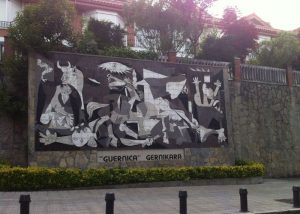
Gernika’s (written in Basque) historical relevance
Guernica, is a famous mural by Pablo Picasso’s which depicts the violence and chaos of war. Moreover, it is thought to be a response to the 1937 bombing of Guernica.
The Basque people continued to suffer under Franco´s regime. As a result, a group of Basque separatists formed Euskadi Ta Askatasuna (ETA) in 1959. Furthermore, the separatist group conducted a decades-long terrorist campaign that ultimately killed over 800 people. ETA disbanded in May 2018.
Traditions
The Basque Country is a territory of traditions and culture. It is known for its fiestas and festivals which take place all year round.
Also read: The running of the bulls – San Fermin 2022
Basque dance
Not just a dance, the Basque Country dance is a way of saluting or thanking somebody or solemnising a religious or social event.
Moreover, there are a large number of Basque dances. Here are just a few;
- Fandango (typical, mixed dance based on a waltz rhythm)
- Ikurrin dantza or Agintariena (the dance of the Basque Flag)
- Agurra (the bow – is danced in ceremonies and to bow to important personalities)
- Mutxikoak (the Basque jumps is one of the oldest traditional Basque dances)
Furthermore, in every village you can see a Basque dance spectacle.
Basque songs and instruments
Basque dances have always been accompanied by the music of traditional Basque instruments. Some of these include the txirula, the txistu and the tamboril and the accordion.
Furthermore, the Basque Country is filled with singers. There probably isn’t a single family reunion that does not involve the singing of traditional songs… in Euskara of course.
Basque games of strength and skill
The games have existed for centuries. They originated in the performance of everyday work when young Basques would call out challenges from farm to farm.
The most well-known are;
- cutting a log with an axe
- dragging a rock
- lifting a rock
- bow and arrow shooting
You can see these in action at numerous festivals throughout the year.
Cities and villages
La Ría de Bilbao and the bridges
During a visit to Bilbao, you can take as your point of reference the river Nervion and La Ría (the estuary). This is where ships used to arrive and where the important industries were located. The river and estuary today remain a key part of city life. Following its course you’ll come to the Puente Bizkaia or Puente Colgante (hanging bridge), a jewel of industrial architecture designed by a student of Eiffel and a UNESCO World heritage Site. Discovering La Ría and its bridges is a journey through the city’s history.
La Ría also takes you to the Casco Viejo, or Bilbao Old Town.
Casco Viejo
The old town of Bilbao and is arguably one of the top places to visit in the Basque Country to get a true sense of the history and architecture of this magnificent area of Spain.
Make sure you take a walk through the original seven streets of Bilbao, known as Las Siete Calles, which date back from the 1400s! This is a lively area, and is very close to the hearts of Bilbao’s inhabitants. Here you can enjoy some pintxos and wine or “txikiteando”.
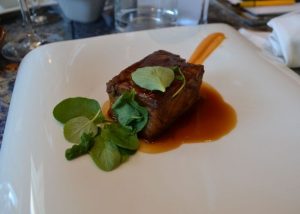
Gastronomy
San Sebastián is widely considered one of the best places in the world to eat. With the exception of Kyoto in Japan, there is no other area in the world with a greater concentration of Mitchelin stars.
The region’s cuisine is built around authentic and local products such as;
- grilled lamb
- cured meats
- salt cod
- sheep
- goat’s cheese
- piquillo peppers
- artichokes
- anchovies
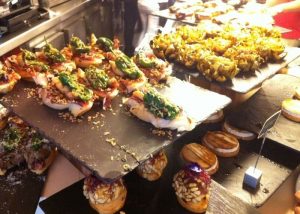
Despite this, you will be just as happy with the local pinchos (tapas) washed down with some Basque cider or txakoli (sparkling white wine).
Also read: Ten beautiful markets in Spain
Wines of the region
You’ll see the names of Basque Country’s premiere wine-growing centres – Samaniego, LaGuardia, Elciego, Labastida – scrawled on chalkboards at bars and cafes all over the region. Sample a Tempranillo or two before heading into the Rioja Alavesa wine region to see how they’re made. Of particular interest are the stunning medieval city of Laguardia and the wineries around it, including Bodegas Ysios and its futuristic ‘temple dedicated to wine’ by Santiago Calatrava.
If you want, you can visit the Bodegas Marqués de Riscal in Elciego.
Marques de Riscal Winery and Hotel
This fantastic Basque winery is connected to a beautiful, historical hotel, designed by none other than the same Frank Gehry who designed the Guggenheim.
Take a guided tour through the wine cellars while discovering interesting facts about the region.
Beaches
The Basque Country coastline stretches for over 175 kilometres along the Bay of Biscay, from across the border with France to the region of Cantabria and is home to many spectacular beaches. From wild, windswept shores to idyllic golden crescents and fabulous urban sandy playgrounds.
La Concha
The moment you arrive in San Sebastián, La Concha beach invites you for a dip or a pleasant stroll along the shore, even in winter. The elegance of the bay, framed by the massif of Igueldo and the island of Santa Clara, is known the world over. San Sebastian‘s La Concha Beach must be one of the most picturesque in the Basque Country. In summer the beach is always filled with people, enjoying its soft sand and brilliant blue waters.
Mundaka
The waves at Mundaka, on Basque Country’s central coast, have long been regarded as the best waves in all of Europe. The natural geography – a sandbar formed by an estuary – creates fast, hollow waves that some surfers have called the finest in the world.
Laga
Stretching for almost one kilometre, Laga Beach is in the Urdaibai Biosphere Reserve. It is roughly a one-hour drive northwest of the city of Bilbao. Surrounded by rolling green hills on one side and Mount Ogoño on the other, it’s a tranquil spot. It is also a popular place for kayaking and surfing.
Laida
Also in the Urdaibai Biosphere Reserve, Laida is yet another spectacular beach. The golden sand sits along the Mundaka Estuary and offers a lovely view of Izaro Island. The beach is also the ideal spot for several activities such as canoeing, sailing and surfing. The water is also very shallow. Therefore, it is perfect for children.
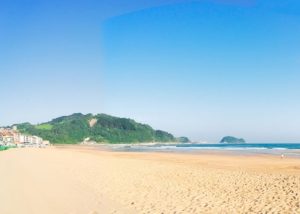
Zarautz
This is the longest beach in the Gipúzkoa province at 2.5km. Families and sunbathers congregate at the western end, playing in the shallows; surfers catch the waves in the centre; and wide dunes sit at the eastern end, providing a home for many species of wildlife.
Karraspio Beach, Lekeitio
Half way between Bilbao and San Sebastian sits the small town of Lekeitio, at the mouth of the Lea River, where it meets the ocean. A sandy beach extends on one side of the estuary, while in the middle sits San Nicolás Island. You can access the island on foot at low tide.
Also read: Blue flag beaches in Spain
Nature
The wide variety of natural resources allows you to try a range of activities and experiences that make the Basque Country a great ecotourism destination.
You can find plenty to do, such as;
- nature photography
- watching different species of birds, land mammals and whales
- discover the natural environment, geological trails or discovering and enjoying the traditions of an ancient people, among others.
The Basque Country has been a signatory to the Daimiel Ecotourism Declaration since 2016 and it is part of the Spanish Ecotourism Association through the Basque Coast Geopark.
Also read: Ecofriendly ferry from Bilbao to Portsmouth
Highlights
San Juan de Gaztelugatxe’s stairway to heaven
It is quite a trek reaching the ninth-century religious site of San Juan de Gaztelugatxe – 241 steps, to be exact. But the views from the top of the island make the effort worthwhile.
Gaztelugatxe comes from the Basque gaztelu (castle) and aitz (rock). The original hilltop church, dedicated to Saint John the Baptist, was demolished, and rebuilt. However, ‘castle rock’ remains an apt description of this Basque landmark.
Take in sweeping views of the dramatic coastline and the crashing waves below. You may also see Basque fishermen making the pilgrimage along with the tourists. Tradition makes for a hike to the church ask to for the saint’s blessing for a bountiful fishing season ahead.
The cobbled streets of Vitoria-Gasteiz
Vitoria-Gasteiz is just a short distance from Rioja Alavesa, so you can combine a visit to the city with the pleasure of discovering some of its famous wineries. Although the Basque capital doesn’t see as many tourists as Bilbao or San Sebastián, the historic centre is considered the best-preserved medieval centre in Basque Country. Furthermore, the impressive 13th-century Cathedral Santa María, a Gothic landmark is perched at the summit of the old town.
The Cathedral
Also located in Vitoria-Gasteiz, the gothic Cathedral of Santa María should be one of the first items on your list. It was actually built as a church-fortress to be part of the city’s defence structure. Various novelists such as Ken Follett took inspiration from the cathedral. Old Gasteiz also boasts the status of a Historic Site. Its street names – Cuchillería, Herrería, Pintorería, Correría, etc. – recall the trades of the guilds (cutlers, smiths, painters, and harness makers, respectively) to which they were home.
The Cristobal Balenciaga Museum
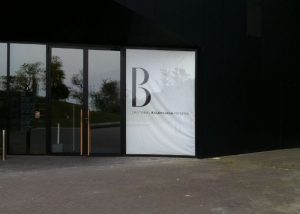
If you are a follower of fashion, this is one of the best places to visit. Located in Getaria, will find some of the best designs from local designer Cristobal Balenciaga.
Cristobal Balenciaga rose to enormous fame in the 1950s and 60s for his beautifully elegant gowns. His designs saw him dress Spanish royalty as well as celebrities in the US, including first lady Jackie Kennedy.
Culture
Film City
The Basque Country is full of events throughout the year, from a human rights festival in April, to a Jazz festival in July, to the famous film festival in September. Moreover, many international stars visit for the city’s International Film Festival.
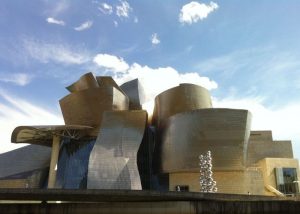
Guggenheim Bilbao
More than an art museum, the Guggenheim Bilbao is a modern architectural landmark. It is a stylised ode to the city’s shipbuilding past and an unmistakable emblem of Bilbao itself. When Frank Gehry’s masterpiece opened in 1997 – on the banks of the Rio Nervión, in a derelict and highly polluted area that was previously an industrial wasteland – it was a symbol of revitalisation and the dawn of a new era for the city.
You must visit and see for yourself how design and architecture impregnate the whole city, starting with the Paseo de Abandoibarra which is very close to the museum. It is an undesputed, charming area where tourists and locals, joggers, and families, mix and meet every day.
